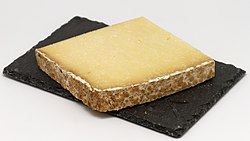Raw milk cheese
Raw milk cheese is cheese made from milk that has not been heat-treated (> 50 ° C) or pasteurized at 72–75 ° C ( raw milk ) at the beginning of the dairy process . Most alpine cheeses are made from raw milk. The milk can come from different animal species: domestic cattle , goats , sheep , buffalo .
Cheeses with raw milk
Certain types of cheese must be made with raw milk. Other types of cheese can optionally be made with raw milk. Raw milk cheeses are mostly cheeses that, as products of protected origin (PDO), are subject to special requirements that are defined in a so-called specification sheet. Many types of raw milk cheese can also be found in organic cheeses.
Examples
Allgäuer Emmentaler is a German type of cheese g. U., which must be made from raw milk; Camembert de Normandie AOP and Roquefort AOP are French cheeses of protected origin, always made from raw milk.
The standard cheese types Brie , Camembert , Emmentaler can, but do not have to be, made with raw milk (Appendix 1 of the German Cheese Ordinance).
Certain types of cheese are made from raw milk and carry the raw milk label. Nonetheless, it heats up to over 40 ° C during manufacture. With hard cheese, this is what is known as the burning of the curd . Temperatures of 50 to 60 ° C are usually used. The heating is necessary so that the curd loses as much water as possible in the form of whey . This is the only way to achieve the specific properties of hard cheese and its long shelf life.
Examples of hard cheese, always made from raw milk:
- Parmigiano Reggiano DOP
- Sliced cheese
- Gruyere
- Sbrinz
- Emmentaler AOC
- Allgäu Emmentaler PDO
- Emmental de Savoie AOP
- Cantal , Salers , Laguiole
Legal basis for labeling
Raw milk cheese must be labeled as such. This is done by indicating made with raw milk (Annex III, Section IX, Chapter IV, No. 2 of EC Regulation 853/2004). Other milk products made from raw milk are also labeled in this way.
Pre-packaged cheese contains the raw milk label on the packaging. For cheese at the cheese counter, there is a note on the signs.
Function of the raw milk reference
Soft cheese made from raw milk can pose a health risk for certain people because of the risk of developing listeriosis . These include infants, toddlers, pregnant women, old people and people with a weakened immune system . These people should know the risks of consumption and weigh up whether they should refrain from consuming it. The raw milk information will help you when choosing cheese.
Web links
- Nikolaus Barkow: slowfood-hamburg.de Raw milk cheese: A safe pleasure In: Slow Food Hamburg . Retrieved February 21, 2010.
- Oliver Keppler: tagesspiegel.de Raw milk cheese: Clash of Cultures In: Tagesspiegel , July 20, 2008.
